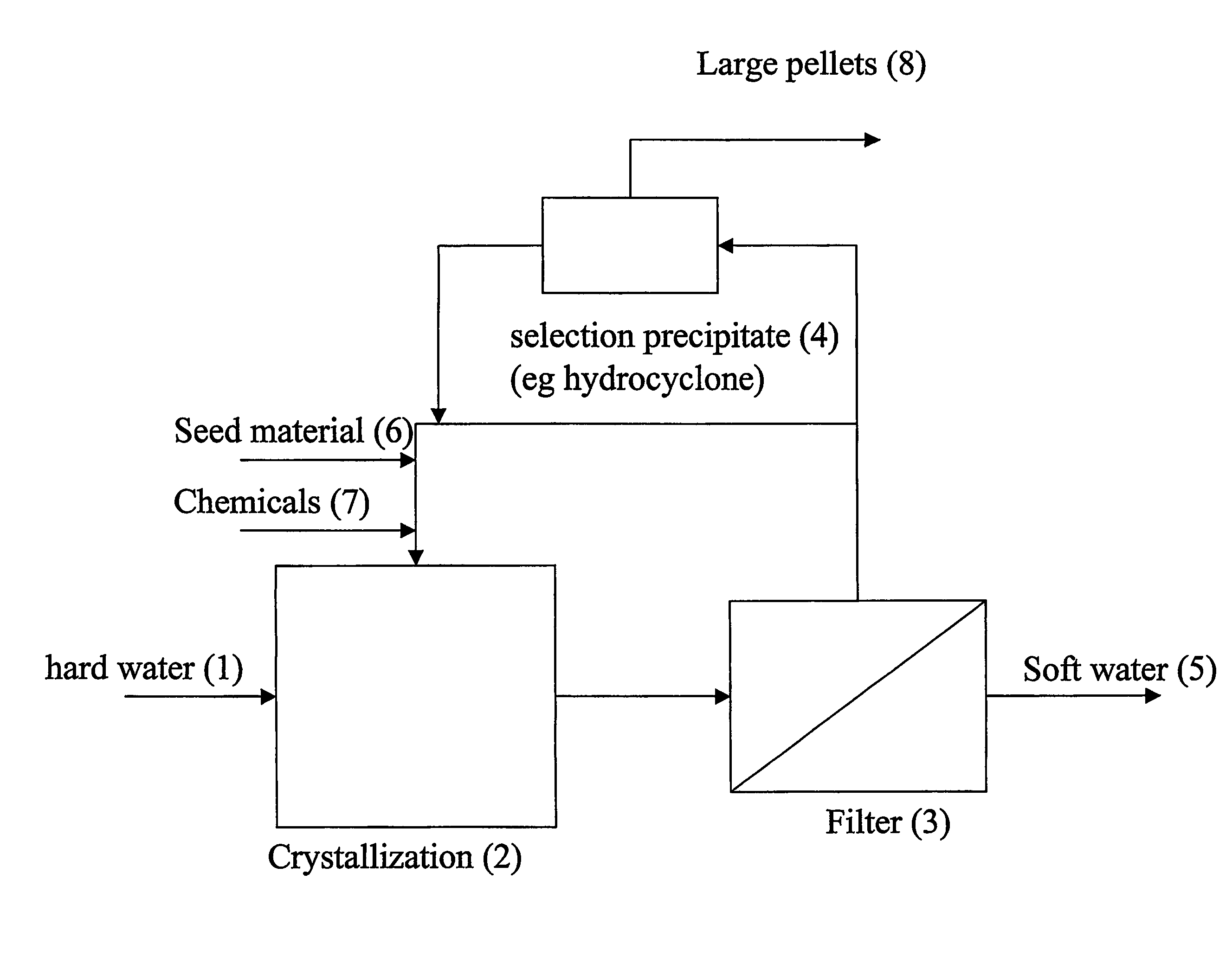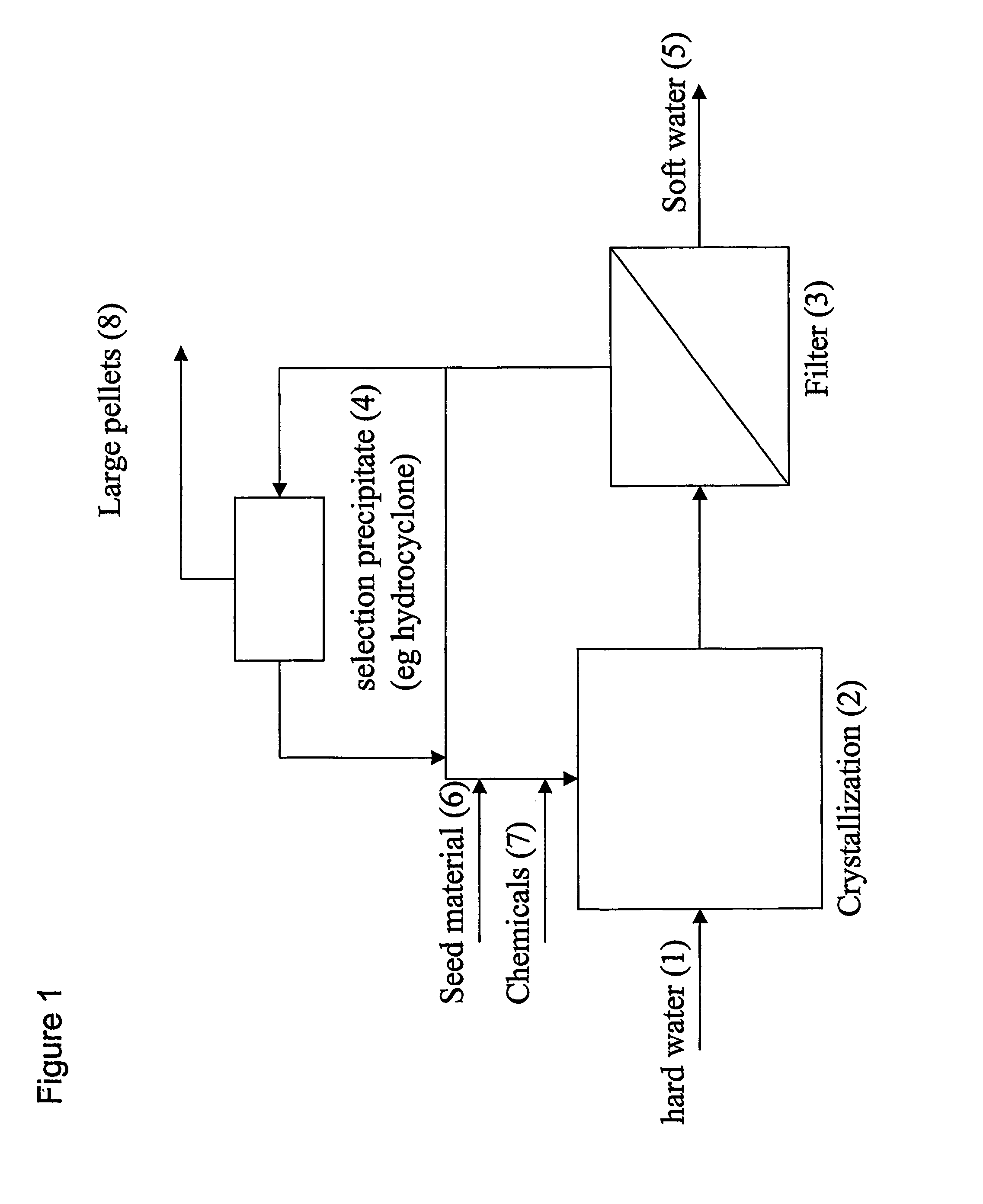Method for removing at least one constituent from a solution
- Summary
- Abstract
- Description
- Claims
- Application Information
AI Technical Summary
Benefits of technology
Problems solved by technology
Method used
Image
Examples
example 1
[0047]In this example groundwater was softened using the filtration assisted crystallization technology. The set-up is depicted in FIG. 3. The seed material used comprised calcium silicate particles having a mean diameter of 15 μm. The size of the crystallisator was 160 L. The pH in the crystallisator was adjusted to a pH of 8.6 by using a caustic soda solution (1 M). Also seed material was pumped as a slurry into the crystallisator (1 gram of seed material per liter hard water). From the crystallisator the now softened water with the crystallized calcium carbonate on the seed material is pumped with a constant flow (800 l / hour) to a pulse tube filter (the average pore size of the cloth filter was 60 μm). In this case a constant filtration flux was obtained of 4 m3 per m2 filter surface area per hour. After 4 hours the filtration was stopped and the cake was removed as a slurry from the filter. The removed cake was used in the next cycle as seed material. The conditions of the secon...
example 2
[0048]In this example waste water from the paper and the pulp industry was softened using the filtration assisted crystallization technology. The set-up is depicted in FIG. 3. The seed material used comprised calcium silicate particles having a mean diameter of 15 μm. The size of the crystallisator was 160 L. The pH in the crystallisator was adjusted to a pH of 8.3 by using a caustic soda solution (5 M). Also seed material was pumped as a slurry into the crystallisator (1 gram of seed material per liter hard water). From the crystallisator the now softened water with the crystallized calcium carbonate on the seed material is pumped with a constant flow (800 l / hour) to a pulse tube filter (the average pore size of the cloth filter was 60 μm). In this case a constant filtration flux was obtained of 4 m3 per m2 filter surface area per hour. After 4 hours the filtration was stopped and the cake was removed as a slurry from the filter. The removed cake was used in the next cycle as seed ...
example 3
[0049]In this example waste water from the paper and the pulp industry was softened and filtered with a wire gauze filter. The set-up is depicted in FIG. 3. The seed material used comprised calcium silicate particles having a mean diameter of 15 μm. The size of the crystallisator was 160 L. The pH in the crystallisator was adjusted to a pH of 8.3 by using a caustic soda solution (5 M). Also seed material was pumped as a slurry into the crystallisator (1 gram of seed material per liter hard water). From the crystallisator the now softened water with the crystallized calcium carbonate on the seed material is pumped with a constant flow (400 l / hour) to a filter (the average pore size of the cloth filter was 60 μm). In this case a constant filtration flux was obtained of 2.5 m3 per m2 filter surface area per hour. After 3 hours the filtration was stopped and the cake was removed as a slurry from the filter. The removed cake was used in the next cycle as seed material. The conditions of ...
PUM
| Property | Measurement | Unit |
|---|---|---|
| Pore size | aaaaa | aaaaa |
| Pore size | aaaaa | aaaaa |
| Pore size | aaaaa | aaaaa |
Abstract
Description
Claims
Application Information
 Login to View More
Login to View More - R&D Engineer
- R&D Manager
- IP Professional
- Industry Leading Data Capabilities
- Powerful AI technology
- Patent DNA Extraction
Browse by: Latest US Patents, China's latest patents, Technical Efficacy Thesaurus, Application Domain, Technology Topic, Popular Technical Reports.
© 2024 PatSnap. All rights reserved.Legal|Privacy policy|Modern Slavery Act Transparency Statement|Sitemap|About US| Contact US: help@patsnap.com










